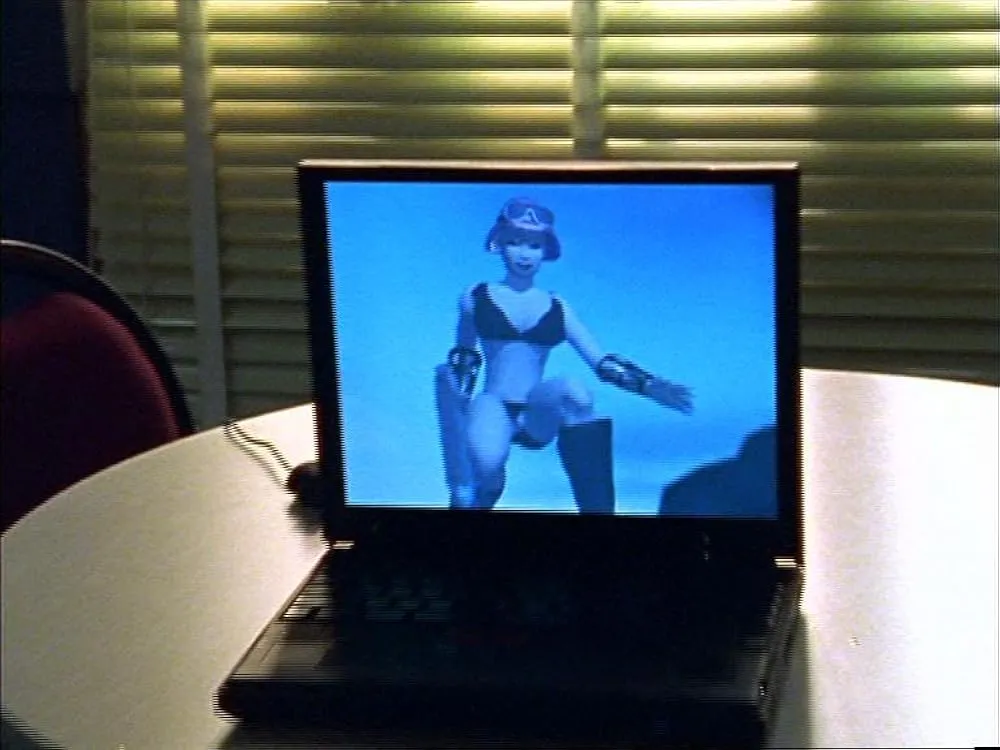
Homicide.com (S07E13)
Airdate: 5 February 1999
Written by: Sara B. Cooper
Directed by: Jay Tobias
Running Time: 43 minutes
The emergence of the internet into mainstream American culture during the 1990s provoked a wave of cultural anxiety, particularly within Hollywood, which consistently framed the nascent technology as a threat to society. Films like The Net (1995) depicted the online world as a haven for criminals, hackers, and psychopaths, reinforcing fears that this new medium would unleash humanity’s darkest instincts. Broadcast television executives, wary of the internet’s potential to disrupt passive viewership, similarly treated it with suspicion. This technophobic narrative reached its zenith in Homicide.com, the episode of Homicide: Life on the Street’s seventh season. The show, celebrated for its unvarnished portrayal of urban policing, here succumbs to the era’s paranoia, framing the internet as an amoral realm where violence and exploitation thrive.
The episode opens with a chilling online video stream of a masked killer’s ritualistic murder of a young woman, Shana Siegel. When her body is discovered, Detective Renee Sheppard is tasked with investigating—a fraught assignment given her recent recovery from a brutal assault. The case sparks a media frenzy, with the Homicide Unit pressured to deliver swift justice. The killer, styling himself after Jean-Luc Godard’s Alphaville antihero Lemmy Caution, evades detection through sophisticated digital evasion tactics. His taunts escalate as he claims a second victim, prompting Colonel Barnfather to demand Sheppard’s removal from the case. Her partner, Detective Tim Bayliss, and colleagues rally behind her, however, and the team identifies the killer as Luke Rayland (Benjmain Busch), a privileged, tech-savvy dropout. In a nail-biting climax, Sheppard foils Rayland’s plot to kill a third victim, securing a hard-won victory.
The script, written by Sara B. Cooper, reflects 1990s-era anxieties about technology amplifying human depravity. The internet is not merely a tool for the killer but an enabler of collective moral decay. The audience watching the murder stream—a hive of voyeurs and crime obsessives—is portrayed as complicit in fuelling his narcissism, mirroring broader fears that the web would magnify society’s baser impulses. Even the show’s grounded characters are seduced by the era’s ambivalence toward new media. Detective Bayliss briefly experiments with a personal website exploring Buddhist bisexuality, while Gharty indulges in a Lara Croft-style action game. These moments, meant to underscore the internet’s seductive allure, instead highlight the script’s reductive view of technology as inherently destabilising, whether for self-expression or escapism.
Technologically, the episode strains credulity. The live-streamed murders, watched by thousands, ignore the limitations of mid-’90s dial-up modems—poor at even loading basic web pages. The narrative handwaves this inconsistency, instead citing the “75–100 million computers” then connected globally—a historically accurate figure that underscores how the show inflated the internet’s reach to amplify its menace. This exaggeration mirrored contemporary fears: in an age of dial-up and chatrooms, the web was mythologised as a realm where anyone could vanish, commit atrocities, and evade accountability. Homicide.com leans into this mythology, framing the killer’s crimes as both technologically sublime and morally nihilistic.
The episode’s true failing lies in its reliance on cliché. The “Lemmy Caution” killer—arrogant, hyper-intelligent, and obsessed with toying with law enforcement—is a trope as stale as it is pervasive. His motive lacks psychological depth, reducing him to a plot device rather than a credible antagonist. The Homicide Unit’s procedural rigor, usually meticulous and grounded, is sidelined in favour of high-stakes theatrics. By the finale, the episode feels less like Homicide: Life on the Street’s gritty, unpolished realism and more like a generic thriller echoing the slick aesthetics of later shows like CSI.
Worse still is the mismanagement of Renee Sheppard’s character. Introduced as a capable rookie, her arc here is muddled by forced drama. Writers, perhaps seeking to capitalise on Michael Michele’s star power, frame her investigation as a redemption arc post-beating. Yet her doubts about her abilities feel contrived, her interactions with colleagues stilted, and her triumph overly contrived. Michele’s performance, while earnest, cannot salvage dialogue that infantilises her character, contrasting sharply with the nuanced work of veterans like Yaphet Kotto and Kyle Secor.
Homicide.com ultimately stands as a disappointing coda to a once-brilliant series. Its attempt to grapple with the internet’s societal impact is overshadowed by melodrama, cliché, and a disconnect from the show’s signature realism. While it captures the era’s anxieties about digital connectivity, it sacrifices the series’ soul for sensationalism. In its final season, Homicide: Life on the Street—once a landmark in police procedurals—succumbed to the very forces that once defined its integrity.
RATING: 3/10 (+)
Blog in Croatian https://draxblog.com
Blog in English https://draxreview.wordpress.com/
InLeo blog @drax.leo
LeoDex: https://leodex.io/?ref=drax
Hiveonboard: https://hiveonboard.com?ref=drax
Rising Star game: https://www.risingstargame.com?referrer=drax
1Inch: https://1inch.exchange/#/r/0x83823d8CCB74F828148258BB4457642124b1328e
BTC donations: 1EWxiMiP6iiG9rger3NuUSd6HByaxQWafG
ETH donations: 0xB305F144323b99e6f8b1d66f5D7DE78B498C32A7
BCH donations: qpvxw0jax79lhmvlgcldkzpqanf03r9cjv8y6gtmk9